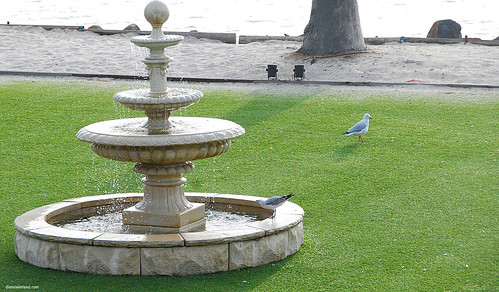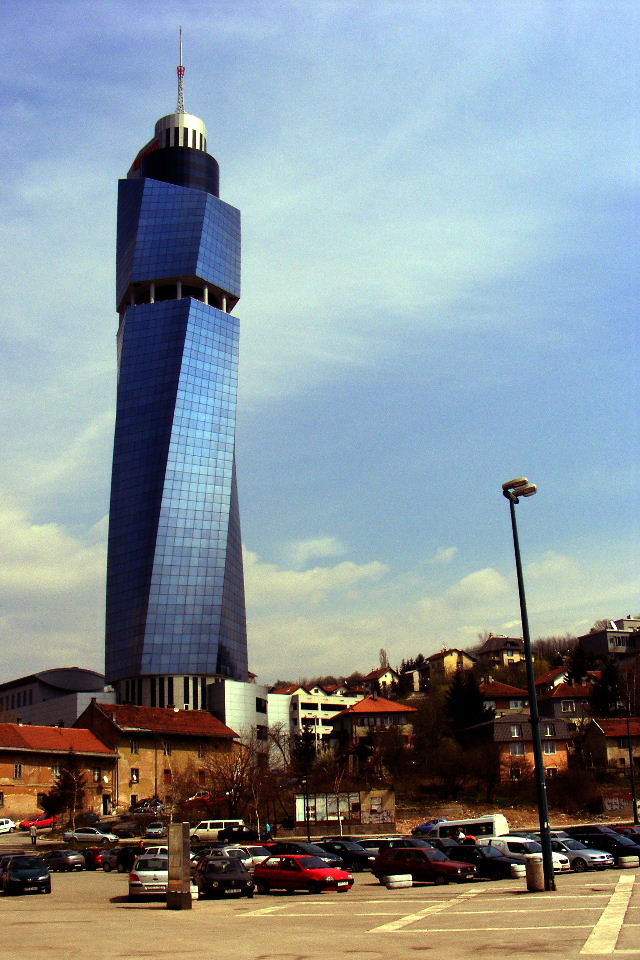It's late afternoon somewhere on the western freeway in Victoria. There are five of us in the car, heading out to climb some rock faces in the rugged Grampians ranges of Western
Victoria. We are passing the outlaying suburbs of Melbourne. A well familiar sight to anyone in Australia, the US and anywhere where cars have shaped city growth. Suburban sprawl as its known, areas filled with single story houses connected by vast network of highways. A sea of terracotta-tiled and metal roofs copied and pasted as far as the eye can see.
I know that very soon this landscape will change dramatically to one I'm more at ease with: endless
eucalyptus woodlands and grasslands. Ah, the countryside.
I'm in the back of the car, daydreaming, while the driver and another passenger are engaing in a debate. One of them
, a German, is obviously irritated by the strange look of this built landscape outside. These houses are substandard and dysfunctional. The proud Aussie, however, defends the houses. After all these are cost effective buildings that rely on 100 year-old construction techniques. The astonished German wonders what architects do in this country. The Aussie reassures him that architects are "just" designers. How could
they possibly improve these buildings, or these places? The German becomes uncomfortably quiet. Indeed they are designers. How could design be of any value...?
Thoughts in my mind are on the 5% of new houses that are actually designed by architects (and probably none in suburbs such as the one outside).
We pass the last Victorian era-inspired new estate.
Where the suburbs dream of city, and the fence tames the outback...
Why is it that in the second decade of the 21st century, the overwhelming majority of new buildings is still ignorant of architecture, unmindful of the context and, to cite Robin Boyd - downright ugly? Why is it that architects are thought of as "designers only". Why is design considered unimportant, and is it architects' fault? These are the questions that bother me as scenery gives way to romantic albeit harsh Australian landscape.
Maybe we expect too much from architecture. Architects tend to be idealistic, yes I know that. I
also know that some Politicians like to think that new developments or renewal of urban spots will "enliven" these places and even whole towns. OK, it may even do so, superficially at least, but I don't believe it's architecture's main objective (let alone that of any new built work) to enliven an
environment. Whatever that means...
A friend of mine comes from a tiny
picturesque village in the
Adriatic (right accross from Venice). He frequently jokes about locals' unenthusiastic view of life, endless complaints about the (few) tourists that
somehow end up on this island, the lack of fish, and complaints about the tourists when they
don't appear at all. Those damn tourists...
Closer to home, I've stayed in locations far from cities, worked on farms surrounded by acres of unspoiled forests, and seen occupants equally unhappy. They like to complain about city folks in Sydney and Melbourne.
Yet to anyone outside, these places are paradise. Clearly, environment by itself, both built or natural, does not provide a good indication of people's happiness. Yes, you can give a beggar new clothes, it may even put a smile on his/her face, but it will probably not change much. People always want more.
So if architecture can't bring happiness, why bother then?
Because happiness in the above sense is a superficial notion, and architecture and design go deeper than that. Because buildings and the state of our environment is a reflection (a mirror) of ourselves. And we surely don't like what we are seeing:
materialism, conformism, meaninglessness, superficiality...confusion?
Ehm, not quite how you like to see yourself. I don't.
If there is one thing that drives me in life it is my core values, my world view (which is quite flexible, something I learned the hard way - link). To have a purpose in life or a driving force is often regarded as a goal in
individuals life, to have a meaningful existence. I would often feel depressed during periods when I felt my work was of no value, that my life was being wasted. Jobs that paid reasonably well, but which left me completely drained and unmotivated.
Design reminds us of those core values. Societal and our own.
But if majority of buildings speak materialism, boredom, and regularity, then it only reinforces those things in
us. Add to that the confusion that many "designed" buildings bring and no wonder we have cities of today: A hotchpotch of styles, messages and confused looks. Confused building in a confused environment. We are indeed
screaming back at ourselves
à la
Edvard Munch's well known painting.
In Australia, we like to call strangers
mates but at the same time our fences are growing steadily higher. In the large cities neighbours rarely speak to one another. We don't like to see ourselves that way, so can architecture help? Can good design remind us of those values we think of as our own? Perhaps we are not giving
architecture a
fair go.
The three days spent hiking and climbing in Grampians had recharged my batteries and reinstated my confidence in this life (not that I was exactly suicidal), throwing into disrepute my theory on
environment and happiness. But I know reality will quickly strike, when we begin to pass those same Quasi-Victorian developments on the outskirts of Melbourne. Those same houses that you encounter in Alice Springs, Kalgoorlie, Cairns, and Sydney, in desert and tropics alike, completely oblivious to their surroundings.
Yet I also know there is hope because change starts at home. It just takes effort and time. That and being true to our values. Always.
In the meantime, we'll just blame the architects...






